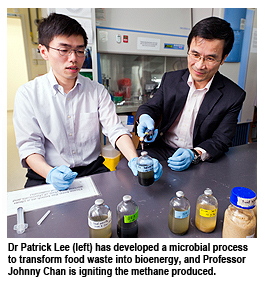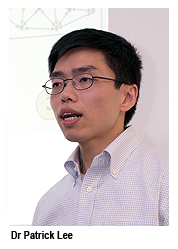CityU environmental scientist turns food waste into bioenergy source
Karen Cheng
An environmental scientist at City University of Hong Kong (CityU) has successfully transformed food waste into bioenergy that can be used to generate heat and electricity, and at the same time reduce the volume of food waste destined for landfills by at least 50%.
The innovative process devised by Dr Patrick Lee Kwan-hon, Assistant Professor in the School of Energy and Environment (SEE) at CityU, uses a mixture of bacteria to create the bioenergy from food that gets wasted, heralding the possibility for the development of a viable source of renewable energy for Hong Kong.
Hong Kong generates over 1.3 million tonnes of food waste every year, which accounts for one third of municipal solid waste, the majority of which ends up in landfills.
Professor Johnny Chan Chung-leung, Dean of SEE, said there is an impending need to tackle the ever-increasing food waste problem.
“Organic waste materials should no longer be treated as waste, but as a valuable resource that can be recovered and transformed into useful products. Through the work of our faculty members and researchers, we hope to harness the potential of food waste and contribute to a more sustainable and green environment for Hong Kong and around the world,” Professor Chan said.
With close to HK$1 million in funding from the Research Grants Council, Dr Lee embarked on a study a year ago to identify the right mix of naturally occurring bacteria that can efficiently transform food waste into bioenergy.
Using advanced DNA sequencing technology, Dr Lee investigated the unique biological features of individual bacteria, looking at how they work together as a group in an anaerobic environment (without oxygen) to produce methane, a commonly available fuel on earth and the main component of natural gas. A combination of a few hundred types of bacteria was identified as a result.
Dr Lee said his team’s research showed the microbial process was effective in producing methane to generate heat and electricity, thus reducing our dependence on fossil fuels. According to their research data, the amount of electricity generated through this process could potentially cover 1 to 2% of local consumption if all the 1.3 million tonnes of food waste were converted, he said.
The process has the benefit of significantly reducing the amount of food waste and our overall carbon footprint. Dr Lee said at least 50% of the volume of food waste would be reduced during the conversion to methane, a process which would lessen the pressure on landfills. The remaining residue, still rich in nutrients such as nitrogen and phosphorous, could be turned into fertilisers through composting, further decreasing this volume by 75%.
From a carbon footprint perspective, this transformation process could reduce 400 kilogrammes of carbon dioxide emissions for every one tonne of food waste treated, mainly as a result of the consumption of the methane produced and the carbon that is stored in the residue.

